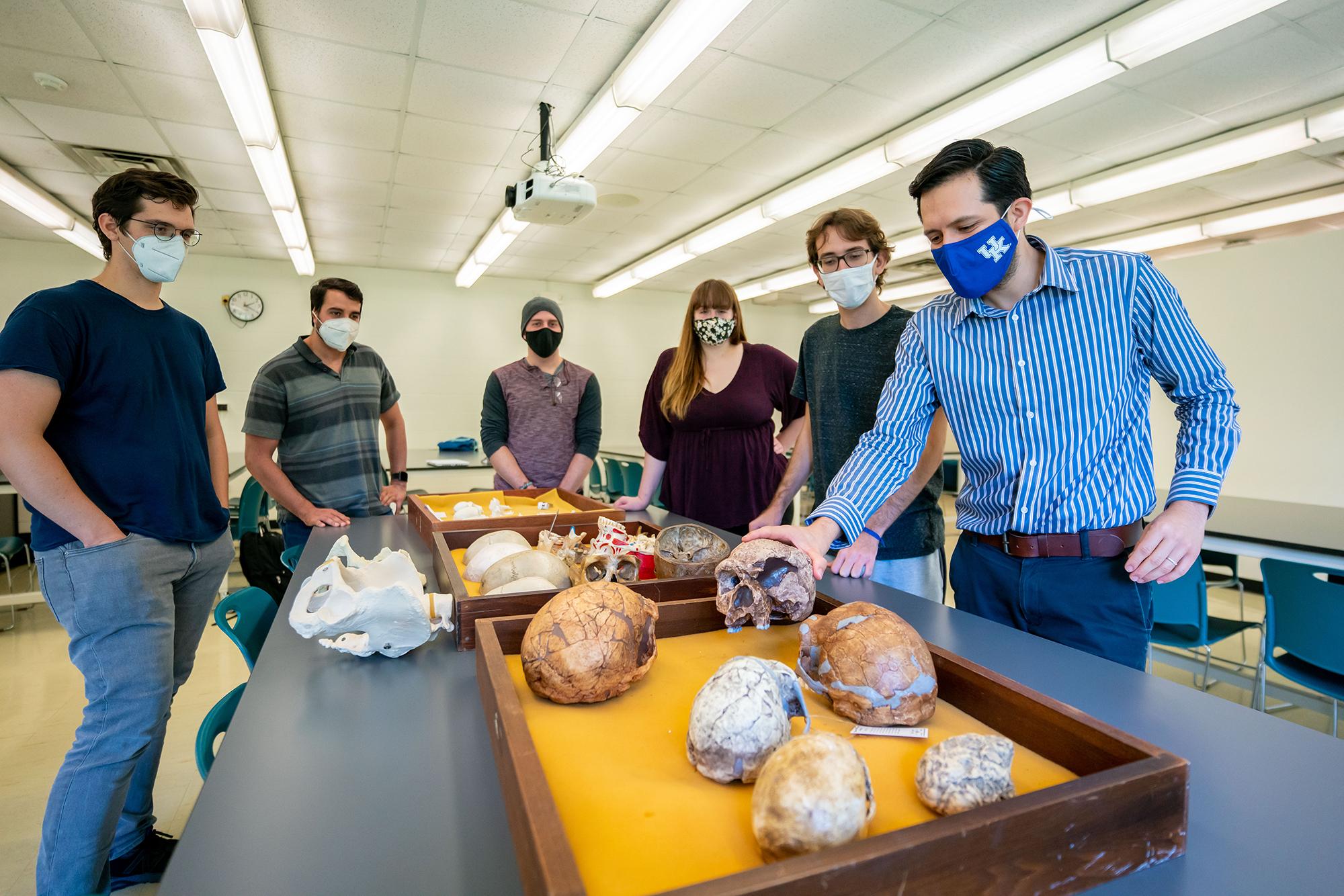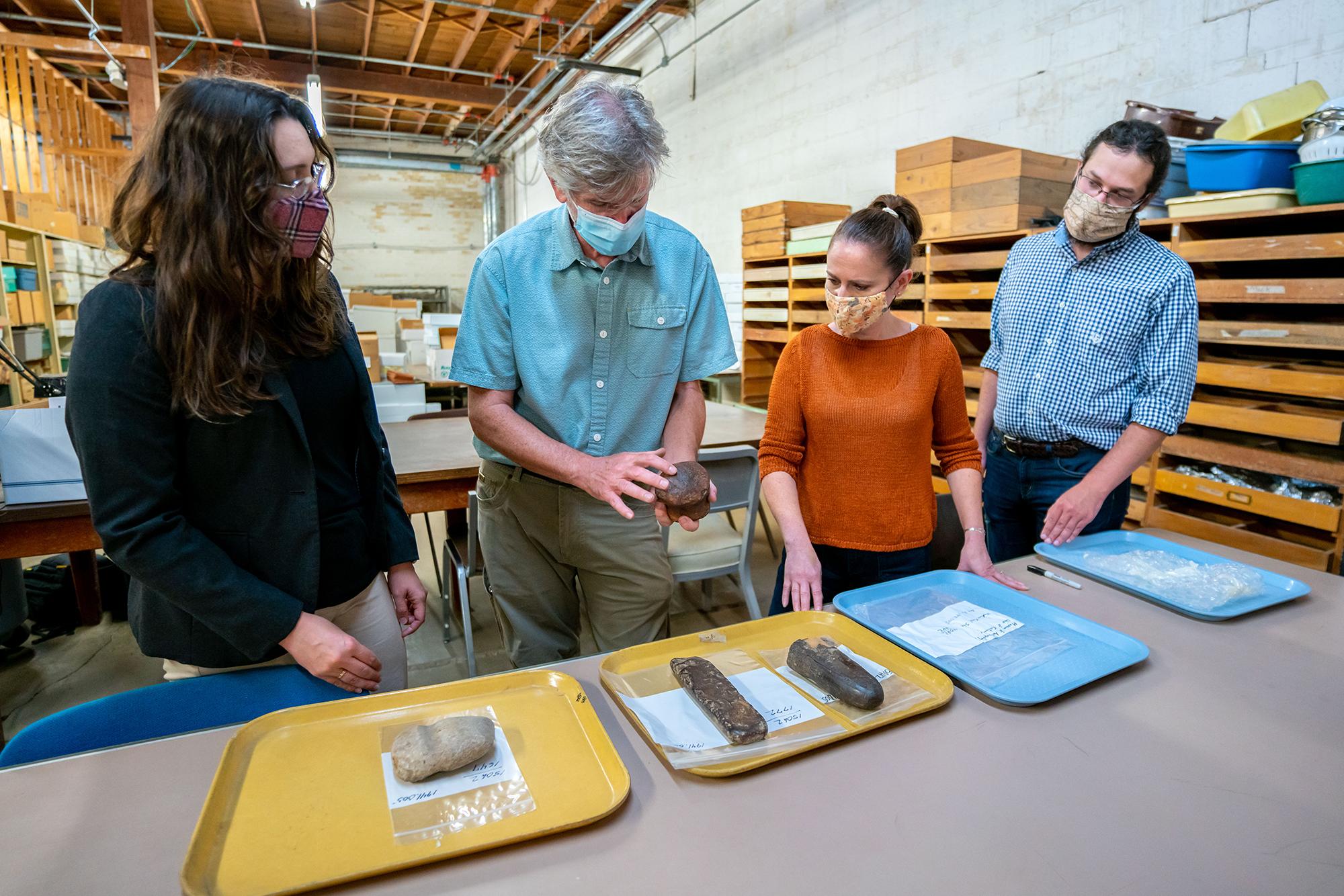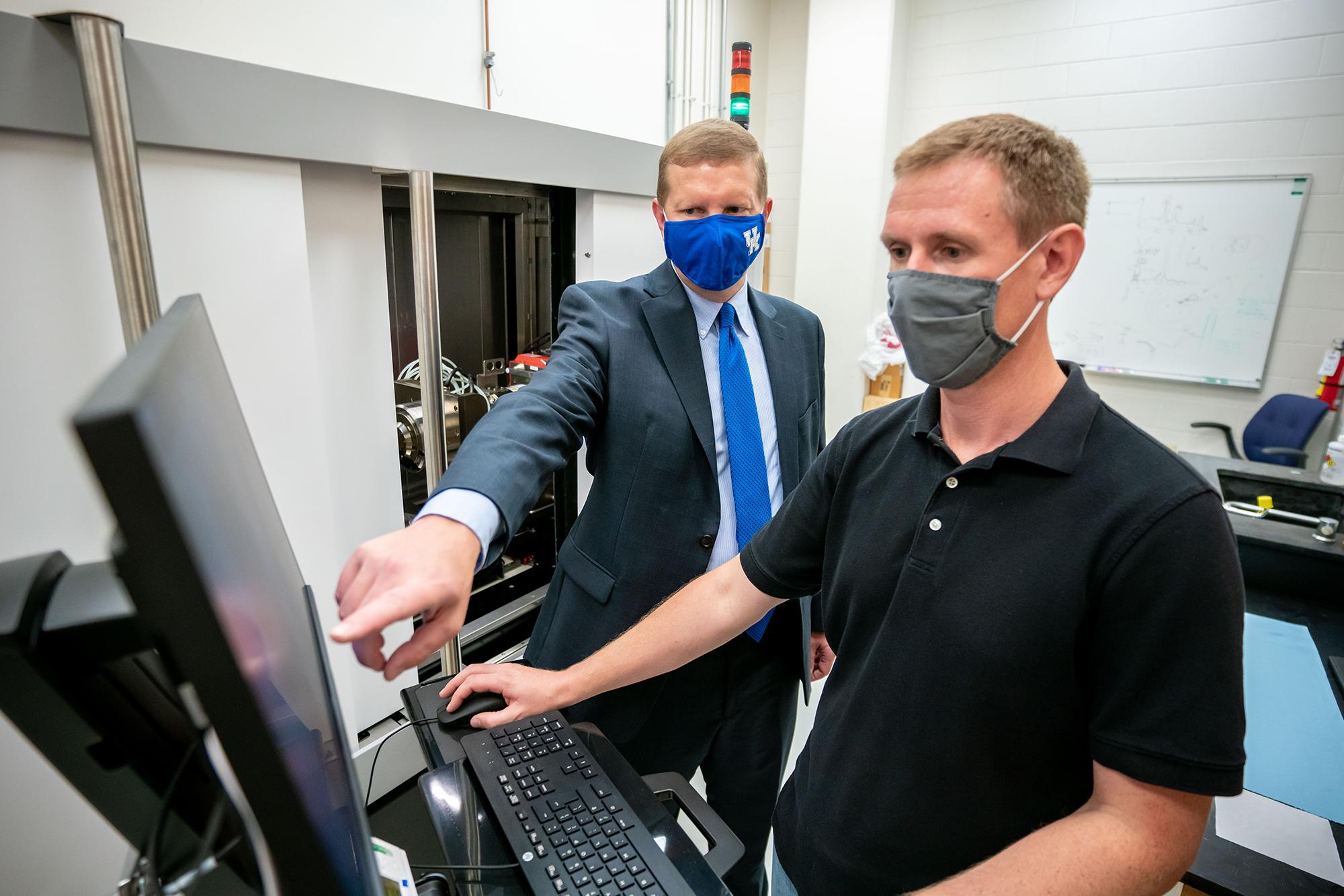By Lindsey Piercy, Alicia Gregory, and Ben Corwin
It’s the signature on a bourbon barrel — it's the ancient footprints in Mammoth Cave.
Heritage science is all around us and has deep roots in the Commonwealth.
Kentucky’s story begins in prehistoric times, when mammoths roamed the Ohio River Valley at Big Bone Lick.
Now, thanks to a $14 million infrastructure grant from the National Science Foundation, the University of Kentucky is poised to tell that story in new, groundbreaking ways through the lens of heritage science.
“We are at a turning point,” Brent Seales, UK Alumni Professor in the Department of Computer Science, said. “Science and technology present a host of exciting opportunities to the heritage sector. They must not be wasted.”
For more than 20 years, Seales has been working to create and use high-tech, non-invasive tools to rescue hidden texts and restore them to humanity. Dubbed “the man who can read the unreadable,” he has garnered international recognition for his “virtual unwrapping” work to read damaged ancient artifacts — such as the Dead Sea Scrolls and Herculaneum papyrus rolls — without ever physically opening them.
Now, Seales is expanding his research.
 Using the NSF infrastructure funding, he has gathered a team of experts from the College of Engineering and the College of Arts and Sciences to build EduceLab — UK’s vision for next-generation heritage science. The collaborative facility will focus on developing innovative artificial intelligence (AI) solutions for the unique challenges presented by cultural heritage objects.
Using the NSF infrastructure funding, he has gathered a team of experts from the College of Engineering and the College of Arts and Sciences to build EduceLab — UK’s vision for next-generation heritage science. The collaborative facility will focus on developing innovative artificial intelligence (AI) solutions for the unique challenges presented by cultural heritage objects.
Heritage science draws on engineering, the humanities and the sciences to enhance the understanding of our past, inform the present and guide our future. Ultimately, the goal is to enrich people’s lives and celebrate both the commonality and diversity of the human experience.
“The word Educe means ‘to bring out from data’ or ‘to develop something that is latent but not on its own explicit.' That’s what we’ve been doing with our virtual unwrapping work. And that context has created an opportunity to expand the very focused question of, ‘Can we read what’s inside a scroll?’ to a broader question of, ‘What heritage science questions can we answer right here in Kentucky,’ Seales explained. “My goal is to rally some of the best researchers here around that theme and build a world-class laboratory that allows us to pose and then answer some of those questions.”
And the quest for answers has already begun.
“Here at UK, we are tremendously well positioned to bring in collaborations, because we have all major colleges in one contiguous campus,” Hugo Reyes-Centeno, an assistant professor in the Department of Anthropology, added. “I see tremendous potential to integrate quantitative analysis and new methodologies that will inform the theoretical perspectives that are the hallmark of the social sciences.”
 Multimillion Dollar Renovation to Enhance William S. Webb Museum
Multimillion Dollar Renovation to Enhance William S. Webb Museum
EduceLab will function as a user facility for the heritage community and have its home base in UK’s William S. Webb Museum of Anthropology, located on Export Street in Lexington, next to the main campus.
Founded in 1931, the museum remains dedicated to enhancing knowledge about and preservation of the nation’s cultural heritage.
The Webb Museum houses a world-renowned archaeological collection from more than 250 properties listed on the National Register of Historic Places — including Native American, Revolutionary War- and Civil War-era sites.
The collections provide a link to the roots of the Commonwealth and its people. Additionally, the immense research archives provide educational services, practical training and research opportunities for the campus community and beyond — making it the ideal location for EduceLab.
“Within Kentucky, it's probably a well-kept secret that we have some of the best collections that relate to this question of the first agricultural populations in Eastern North America. The Webb Museum, which is primarily a research center, is not your classic bricks and mortar display. We maintain the collections for the state of Kentucky for research purposes,” Crothers said. “This is going to significantly impact what we do in the museum, and in archaeology in general, because it's providing us access to the most sophisticated and high-level equipment, which we didn’t have before.”
EduceLab has four parts: FLEX, BENCH, MOBILE and CYBER.
BENCH
 Modern technology is key to understanding how relics of our past were made.
Modern technology is key to understanding how relics of our past were made.
BENCH will work to acquire the instruments needed to conduct leading-edge materials science, which will help establish a comprehensive workflow.
“My role is to bring the perspective of materials characterization. As a materials engineer, I look at what materials are made of. That helps us understand how a specimen was made in the first place and the technology that was used to create it. And I apply that to metals and alloys or ceramics that are used in industry, but we can also apply that to cultural heritage artifacts,” John Balk, William T. Bryan Professor of Materials Engineering and associate dean for research and graduate studies in UK Engineering, said. “It's definitely a new application space for me, but we can apply these scientific techniques and really learn about the material — the artifact — and put that in the right context of cultural heritage.”
FLEX
In 2016, Seales' team developed the Volume Cartographer, a revolutionary computer program for locating and mapping 2D surfaces within a 3D object. The software pipeline is used with micro-CT to generate extremely high-resolution images — enabling the ability to read a document without ever needing to physically open it. The charred scroll from En Gedi was the first complete text to be revealed using the software.
While the first-of-its-kind software has profoundly impacted history and literature, not all damaged artifacts are created equal.
Seales and his team have often found it difficult to use equipment that is poorly suited for the odd shapes and sizes — so they decided to build their own.
“With the FLEX cluster, we will have a prototype environment where we can envision, build and test custom instrument configurations built around the heritage object under study,” Seales said. “That is truly a novel approach not seen anywhere else at the mid-scale level.”
MOBILE
It’s one thing to bring an object into the lab. It’s another to go to the object in the field.
By setting up in the parking lot of a museum or by collecting data at an archeological site, the MOBILE team will take EduceLab on the road.
Suzanne Smith, along with faculty members Sean Bailey and Mike Sama, will deploy the use of unmanned aerial systems for field campaigns. “And in that field campaign, we do all kinds of measurements from the air over a larger area,” Smith, director of UK Unmanned Systems Research Consortium, explained. “It’s using all different kinds of sensors that can give different perspectives on the shapes that are being measured, and we can even see through some of the materials — giving us the historical context of that whole area. It's just such a bigger scale of where that history has happened.”
Additionally, the MOBILE team will use external displays for community involvement. “They can actually see this information coming in,” Smith said. “There are going to be exciting discoveries that happen in the moment, and the public will be able to be right there.”
MOBILE TO CYBER
While MOBILE oversees collecting data, CYBER will be tasked with generating and sharing the data.
As the link between MOBILE and CYBER, that’s where Corey Baker’s expertise in wireless communications comes in. CYBER will be critical when helping to further drive advancements in drone fleets.
“There are a lot of devices in use when it comes to the unmanned vehicles component. They will pick up data and transfer data. But many times, they may not have internet connectivity,” Baker, an assistant professor in computer science, said. “My research focuses on the question, when the internet is limited or nonexistent, how do you build applications and systems to disseminate information?”
Additionally, Baker believes technology should be an enabler not just for researchers, but for the entire community. “These types of projects are not just designed to produce something that looks fancy. But it's designed to make a difference.”
Students Remain Key in Unlocking Sealed Secrets
Over the years, this team of UK faculty members has been as committed to developing students’ talents. By engaging in hands-on research, they’re able to determine an area of interest and jump start their careers.
“I never would have imagined that I would go into academia to pursue some of the questions that always interested me. But if it were not for that undergraduate research experience that ultimately led me to Europe and to the discovery of this field of heritage science, I probably wouldn't be here now,” Reyes-Centeno said. “The undergraduate research component is certainly something we’ll be continuing to develop for our students. Our students must have those opportunities.”
The Promise Moving Forward
Seales is considered the foremost expert in the digital restoration of cultural antiquities. To this day, his quest to uncover ancient wisdom is ever evolving.
Overcoming damage incurred by time is no small challenge. But Seales, and his dedicated team, are committed to conquering the seemingly impossible.
“We're in a time now where our cultural heritage is the key to understanding and embracing our diversity," he said. “Focusing on heritage science can be key to unlocking, in a positive way, how that heritage can help us understand each other, collaborate together and shape our future. We plan to keep showing the world what can be done, right here at UK.”
More information about EduceLab can also be found online.
Research reported in this publication was supported by the National Science Foundation under Award Number 2131940. The opinions, findings, and conclusions or recommendations expressed are those of the author(s) and do not necessarily reflect the views of the National Science Foundation.
